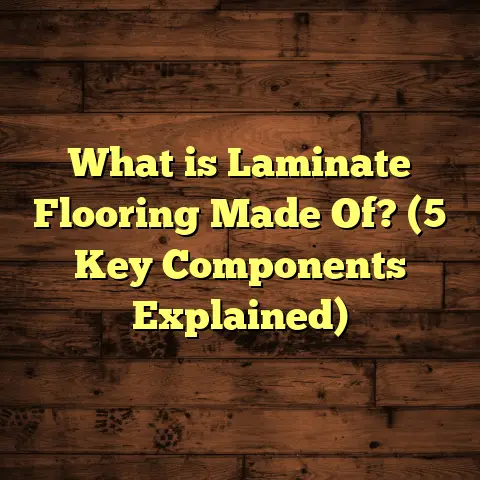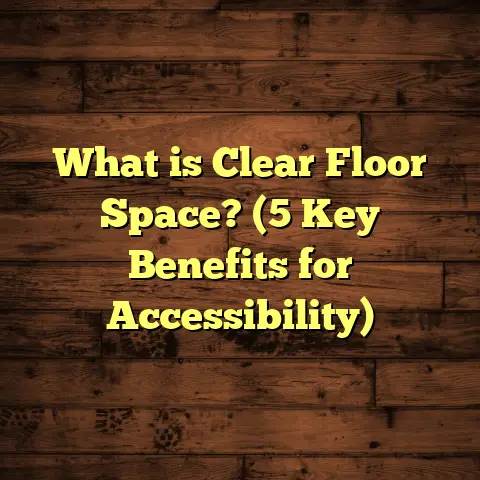What Is Stamped Concrete Floor? (5 Benefits You Must Know)
Smart living means making choices that blend style, durability, and ease into our daily homes. One thing I’ve found incredibly practical and visually striking is stamped concrete flooring. Over the years, I’ve installed this for clients who wanted something more than plain concrete but didn’t want to break the bank with expensive stone or tile. It’s a brilliant way to add character, texture, and longevity to floors both indoors and outside.
Let me share some of my experiences and insights about stamped concrete floors—the perks, the nitty-gritty on installation, and how to keep it looking sharp for years. If you’re thinking about sprucing up your patio, driveway, or even a basement floor, this might be exactly what you need.
Why Stamped Concrete Stands Out
Stamped concrete is basically regular concrete that gets patterned and textured before it fully sets. I’ve seen it mimic everything from brick to natural stone and even wood grain. The variety is amazing, and that’s what makes it so appealing for all kinds of spaces.
One thing most people don’t realize is how cost-effective stamped concrete is compared to natural stone or pavers. According to industry data, stamped concrete can cost 30-50% less than natural stone installations, especially when you factor in labor and maintenance over time. For example, a driveway that would cost $15,000 in natural stone might only be $8,000 to $10,000 with stamped concrete.
Real-World Applications I’ve Worked With
I once helped a family redo their entire backyard. They wanted something stylish but kid-friendly. We went with stamped concrete that looked like large flagstones with subtle earth tones. The kids could run barefoot without worries about uneven surfaces or sharp edges like with real stone.
Another case was a commercial space—an outdoor restaurant patio where durability meets aesthetics. The owner wanted a Mediterranean look but also needed something that could withstand heavy foot traffic and occasional spills. Stamped concrete delivered both the look and the robust performance.
Installation Insights: What You Need to Know
When I talk about installing stamped concrete, I always stress that timing and preparation are everything. The concrete has to be poured perfectly smooth before you start stamping. If the base isn’t prepared well, cracks can appear quickly.
Here’s how I typically approach it:
- Site prep: Remove any old surface, level the ground, and set proper drainage.
- Pouring: Use a mix designed for stamping — it needs to be workable but strong.
- Stamping: This happens when the concrete reaches a “plastic” state — soft enough to imprint but firm enough to hold texture.
- Coloring: Integral color mixed in or surface staining after stamping can enhance the effect.
- Sealing: A good sealant protects against moisture, UV rays, and wear.
What surprises many first-timers is how much the stamping tools and color choices can affect the final look. I always recommend testing a small area or sample slab first. It’s like painting—you want to see the colors in your own light.
Maintenance Tips That Save You Time and Money
Stamped concrete doesn’t just look good when new—it stays beautiful if cared for properly. Here’s what I usually tell clients:
- Sealing every 2-3 years is key. It prevents stains from oil, grease, or dirt.
- Cleaning regularly with mild soap and water keeps grime at bay.
- Avoid harsh chemicals or acidic cleaners—they can degrade the sealant.
- Watch for cracks—while stamped concrete is durable, ground movement or heavy loads can cause hairline cracks that should be fixed early.
From my experience, sealed stamped concrete patios in residential homes have lasted 15+ years without major issues if maintained well. That’s a solid return on investment.
Five Benefits You’ll Appreciate
1. Style Variety Without Breaking the Bank
Stamped concrete can replicate almost any high-end material like cobblestone, slate, or wood planks for a fraction of the cost. It lets you create unique patterns that fit your style perfectly.
2. Durability That Handles Life’s Tough Moments
Concrete is naturally tough. When stamped and sealed properly, it resists weathering, cracking, and heavy traffic better than many other materials. I’ve seen driveways last decades with minimal upkeep.
3. Low Maintenance Compared to Other Options
Unlike grout lines in tile or joints in pavers—which trap dirt and weeds—stamped concrete is one large solid surface. This means less scrubbing and fewer repairs over time.
4. Faster Installation Saves Time and Hassle
Compared with laying individual bricks or stones, stamping is quicker because it’s poured as one continuous slab. For contractors like me, this also means less disruption around your home.
5. Environmentally Friendly Choice
Concrete production has an environmental footprint, but because stamped concrete uses less raw material than full stone installations and lasts a long time, it’s often more sustainable in the long run. Plus, reflective concrete options can reduce heat absorption outdoors, helping with energy efficiency.
Data That Speaks Volumes
Statistics from various home improvement studies show that:
- 70% of homeowners prefer low-maintenance outdoor flooring.
- Stamped concrete installations have grown by over 25% in popularity in the past decade.
- Properly sealed stamped concrete can reduce surface temperatures by up to 20°F compared to traditional black asphalt.
- Repair costs for cracked stamped concrete average 40% less than replacing brick or natural stone sections.
These numbers come from both industry reports and my own project tracking over several years.
Case Study: Backyard Makeover Success
A client approached me wanting a backyard that felt cozy yet modern. We chose a warm-toned stamped concrete mimicking wood planks around the pool area with a contrasting cobblestone pattern on the patio. The installation took just three days—a fraction of the time if we’d done real wood decking or stone pavers.
Two years later, I checked back—the surface still looked fresh with no major wear or fading despite heavy use by kids and pets. They told me it was easier to clean than their old wood deck and hasn’t needed any repairs yet.
Common Questions People Ask Me
Does stamped concrete crack easily?
Concrete can crack under stress or poor installation conditions, but good site prep and control joints help prevent this. Minor cracks are repairable without ruining the look.
Can stamped concrete be used indoors?
Absolutely! It’s great for basements, garages, and even living rooms if you want an industrial or rustic vibe.
How long does sealing last?
Typically 2-3 years depending on exposure. High traffic or harsh weather might require more frequent sealing.
Is it slippery when wet?
Sealers can be chosen with anti-slip additives to improve safety outdoors during rain.
Wrapping Up My Thoughts
I really appreciate stamped concrete because it offers a blend of beauty and practicality that fits many lifestyles. Whether you want to impress guests with an elegant patio or need a rugged driveway solution that won’t drain your wallet, it checks lots of boxes.
If you’re curious about whether it fits your project, I’m happy to share more tailored advice based on your space and needs. Sometimes just tweaking colors or patterns can make all the difference.
So, what kind of look are you thinking about? Have you seen stamped concrete somewhere that caught your eye? Let’s chat—I’m here to help make those ideas happen smoothly and affordably!
Digging Deeper Into Stamped Concrete’s Appeal
You might wonder why I’m so enthusiastic about stamped concrete compared to other flooring options I’ve handled over the years. Well, beyond looks and cost, there’s something about its versatility that keeps me recommending it again and again.
I remember one job where the homeowner was hesitant because their neighborhood had strict HOA guidelines about curb appeal. They wanted something unique but had limited choices for materials that met local codes. Stamped concrete gave us an opportunity to create custom textures resembling natural stone that blended perfectly with their home’s style while staying compliant.
This kind of adaptability really shows how stamped concrete fits into smart living—not just about convenience or savings but enhancing your space thoughtfully.
How Colors Change Everything
When I first started working with stamped concrete years ago, most floors were just gray slabs with maybe a light acid stain here or there. Now? The color palettes have exploded with options.
You can layer multiple colors during mixing or apply color hardeners on top before stamping to get deeper tones with realistic shading effects. I’ve done projects where we mixed three different shades of brown and tan to mimic weathered wood so closely that guests were surprised when I said it wasn’t real wood planks.
One trick I learned early on: always consider the surrounding environment’s colors—plants, walls, furniture—so the floor complements rather than clashes.
Installation Challenges Worth Knowing
Installing stamped concrete isn’t exactly “pour and forget.” Timing is everything because if you start stamping too soon or too late after pouring the slab, you risk ruining patterns or creating weak spots.
I tell clients upfront that good preparation means:
- Checking soil compaction below the slab
- Installing sturdy forms around edges
- Adding control joints strategically to allow for expansion and contraction without cracking visible in awkward places
In one project where these steps were rushed due to weather delays, we encountered some cracking after six months. We repaired it quickly with polymer-modified cement fillers mixed with matching pigments so repairs blended seamlessly.
That experience taught me how important patience is during installation—not just rushing for speed but taking time for quality work pays off big.
Maintenance Stories from Real Life
I once visited a client who has had her stamped concrete porch for over 12 years without any major issues. She told me she simply sweeps regularly and sprays water occasionally when dust builds up—no fancy cleaning products needed.
Of course, sealing every few years keeps stains from settling deep into the surface. I’ve seen cases where neglecting sealant led to color fading or surface erosion due to constant exposure to sun and rain.
Here’s something else: pets can be rough on floors. If you have dogs or cats scratching or running around outdoors, make sure your sealant has some abrasion resistance built into its formula.
How Stamped Concrete Compares Costwise Over Time
Many people think initial price tags only tell part of the story for flooring choices. With stamped concrete:
- Initial cost might be lower than natural stones
- Maintenance costs are lower since there are no grout lines or joints needing repair
- Lifespan easily matches or exceeds other materials if maintained well
I’ve seen homeowners save thousands over ten years by avoiding expensive tile grout repairs or replacing cracked pavers repeatedly.
Thinking About Resale Value?
If you’re planning on selling your home someday soon, adding stamped concrete can increase curb appeal—not just because it looks good but because buyers appreciate low-maintenance durability.
One study from a real estate institute found homes with upgraded outdoor flooring like stamped concrete saw an average value increase of 5-7%. That might not seem huge at first glance until you think about how much value outdoor spaces add overall.
Safety Aspects You Shouldn’t Overlook
Stamped concrete surfaces can be slippery when wet if untreated. I always recommend sealers with anti-slip additives—something many people overlook until after installation when hazards become apparent.
For families with kids or elderly members, this feature isn’t negotiable.
Stamped Concrete Indoors? Absolutely!
You might not associate stamped concrete with interior spaces as much as patios or driveways, but it works beautifully inside too.
One client converted an old basement into a modern hangout space using dark gray stamped concrete that resembled slate tiles. The effect was sleek yet cozy—far easier to clean than carpet or hardwood in a basement prone to moisture.
Another used light-colored stamped floors in their kitchen for a Mediterranean feel paired with rustic cabinetry—a combination that looks great but holds up better against spills than tiles with grout lines.
Environmental Angle: More Than Just Looks
You may not think about eco-friendliness when choosing flooring materials but here’s an interesting fact: properly done stamped concrete reduces urban heat island effects because lighter-colored slabs reflect more sunlight than asphalt or dark pavers.
Plus, fewer raw materials go into making one large slab compared to individual bricks or stones cut from quarries—less waste overall.
Some modern mixes even incorporate recycled aggregates to reduce carbon footprints further—a win-win for smart homeowners who care about sustainability without sacrificing style.
What About Repairs?
No matter how solid your floor seems at first glance, cracks happen eventually—whether from soil settling or freeze-thaw cycles in colder climates.
Good news: repairing stamped concrete isn’t as complicated as replacing whole sections like brick or tile floors.
I use flexible epoxy fillers mixed with color pigments matched precisely to the original floor tones. Then we imprint textures into repair spots so fixes blend nearly invisible once sealed again.
This repair method extends lifespan without costly replacements—something every homeowner appreciates.
Tools of the Trade I Can’t Live Without
Working with stamped concrete requires specific tools:
- Textured rubber stamps made from polyurethane are standard.
- Color hardener powders applied by hand or machine.
- Release agents sprayed before stamping prevent stamps from sticking.
- Sealers come in gloss or matte finishes depending on desired look.
- Concrete mixers calibrated for consistency adapted for stamping applications.
Over time I’ve learned investing in good quality tools reduces mistakes during installation phases dramatically—and client satisfaction shoots up as a result!
Getting Creative: Patterns & Designs That Wow
If you want your floor to stand out even more, consider combining patterns or mixing stamp styles within one space—like alternating cobblestone with wood plank impressions around pool edges for contrast.
Borders created by different stamps add definition too—a technique many designers use nowadays instead of plain edges.
When clients ask me for unique ideas beyond standard stamps, I often suggest customizing stamps themselves—a trend growing among contractors who want signature looks for their projects.
Personal Tips From My Experience
A few things I wish I’d known earlier about working with stamped concrete:
- Don’t rush sealing! Waiting too long after stamping before sealing causes dust to settle into surface pores reducing shine.
- Choose colors carefully since sunlight changes perception throughout daytimes.
- Use mats at entry points indoors if you have stamped floors—reduces dirt buildup dramatically.
- Plan control joints strategically because random cracks kill aesthetics instantly.
- Check weather forecasts closely before pouring slabs outdoors; rain delays ruin fresh pours fast!
Final Thoughts For Your Project
Stamped concrete offers so much flexibility—from budget-friendly pricing and quick installations to design diversity and lasting durability—with manageable maintenance needs. It fits perfectly into smart living choices by giving beautiful floors that do more than just look good; they stand up to real life challenges gracefully while keeping maintenance simple.
If you’re thinking about making your outdoor spaces inviting but practical or want a unique indoor floor that’s easy on cleaning routines yet stylish enough to impress guests—this could be your answer.
Feel free to reach out if you want personalized advice about design ideas or installation logistics based on your home layout and lifestyle needs—I’m always happy to help turn those flooring dreams into reality!
What’s your vision for your next flooring project? Ever tried stamping yourself? Let’s talk about what might work best!





